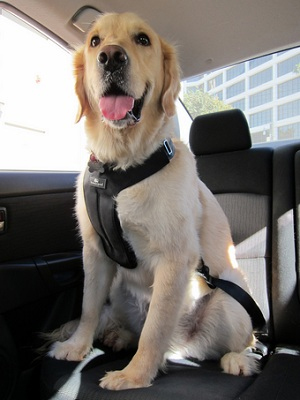On the Road with Your Dog
Traveling by car with your dog can be rewarding for both of you. Sharing a vacation is much more enjoyable than kenneling your dog and going without him. With a little careful planning, you can minimize problems and maximize fun. Before you hit the road, ask yourself a few questions:
- Is my dog accustomed to riding in the car? Does he enjoy car travel?
- Does my dog get carsick?
- Is my dog very active or generally calm?
- Is my dog crate-trained? If so, is my car large enough to accommodate his crate?
- Are there dog-friendly motels or campsites along my route and at my destination?
The answers to these questions should guide you in making your travel preparations. Before departing, do an online search for dog-friendly accommodations and make reservations. It’s increasingly easy to find lodging that welcomes canine guests, but some places have size or breed restrictions.
The safest way for a dog to travel by car is in a crate. If your dog is crate-trained, this should be an easy solution. The crate should be large enough to allow your dog to stand up, turn around and lie down. Make sure it is well-ventilated. Put a crate mat or other absorbent material on the bottom of the crate and give your dog chew toys (preferably non-squeaky) to keep him from getting bored.
A crate also makes a great bed for your dog at your destination, whether it’s a motel, a friend’s or relative’s house or a campsite.
If you have a large dog and your car is too small for a suitable crate, put an absorbent blanket across the back seat and secure him to the seat belt with a tether. These are available in many configurations; check online dog supply sources. Never give your dog unrestricted access to the front seat or let him hang his head out a window.
To get your dog used to car travel, take him on short trips to destinations other than the vet’s. Drive him to a dog park or to pick up the kids. That way, he will associate car travel with positive things. Never leave him alone in the car on a warm day, either around town or on your trip.
Your dog should have a checkup at the veterinarian’s before you leave. Make sure all his vaccinations are up to date, and carry proof with you. Now is the time to ask about motion-sickness medication if your dog gets carsick. If the trip will be long and your dog is very active, ask the vet about a mild sedative.
Some carsick dogs respond well to natural motion-sickness preparations, many of which contain ginger and mint. Antihistamines such as Benadryl can help calm a nervous dog, but don’t give him human medications of any kind without checking with your vet first.
Here are a few supplies you should have with you no matter what your destination:
- Plenty of water and a spill-proof water dish.
- Your dog’s usual food and a spill-proof dish for that
- His medications, if any
- If he’s not traveling in a crate, bring his familiar bedding along
- An identification tag with your cell phone number on it. If he’s micro-chipped, make sure the microchip company has your cell number.
- A collar and sturdy leash.
- Favorite toys—chew toys, plush toys, fetch toys.
- Plenty of poop bags.
As you travel, stop every hour or so to allow your dog to get out, walk around, drink water, and relieve himself. He should be on a leash at all times when he’s not in the car. Always clean up after him.
Once you get to your evening’s destination, play a game of fetch with your dog if possible or take him on a long walk to let him stretch his legs. He’ll sleep better if he’s gotten some exercise.
A dog who reacts to outside noises by barking can get you tossed out of a motel. Playing low music or running a fan or white-noise machine can help calm your dog. Give him a treat-stuffed chew toy to distract him. That mild sedative can come in handy in this case, too.
About the Author: Lisa King is a freelance writer living in Southern California. She is the former managing editor of Pet Product News International, Dogs USA, and Natural Dog magazines. Lisa is also the author of the well-received murder mystery novel “Death in a Wine Dark Sea” and the recently released “Vulture au Vin.”





